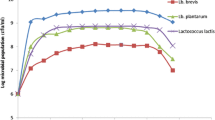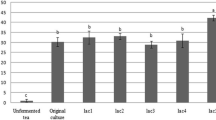Abstract
The purpose of this study was to develop probiotic functional beverage with enhanced physiochemical properties by utilizing dandelion due to its high nutritional value. Lactic acid bacteria obtained from human feces were screened based on bacterial survival ability and cinnamoyl esterase (CE) activity. Dandelion extract fermented by Lactobacillus acidophilus F-46 maintained approximately 105–106 log CFU/mL over an 8 days period. Antioxidant activity by using DPPH radical scavenging activity of the prepared fermented dandelion beverage (FDB) were significantly increased compared to that of non-fermented dandelion beverage (NFDB). Moreover, CE activity was significantly enhanced during fermentation and showed the approximately 4.3 times increased concentration of caffeic acid up to 9.91 mg/100 mL after 8 days of incubation compared to NFDB. Therefore, it concluded that dandelion can be a good source for preparing a functional beverage and fermentation by LA-F46 enhanced the food functionality with enhanced caffeic acids.
Similar content being viewed by others
References
Adisakwattana S, Moonsan P, Yibchok-anun S. Insulin-releasing properties of a series of cinnamic acid derives in vitro and in vivo. J. Agr. Food Chem. 56: 7838–7844 (2008)
Jackson JE, Bressler R. Clinical pharmacology of sulfponylurea hypoglycemic agents: Part 2. Drugs 22: 295–320 (1981)
Jennings AM, Spencer KM, Dean BM, Wilson RM, Bottazzo GF, Ward JD. Islet cell antibodies and insulin autoantibodies in patients treated with oral hypoglycaemic agents. Diabetic Med. 6: 434–439 (1989)
Fuller R. Probiotics in man and animals. J. Appl. Bacteriol. 66: 365–378 (1989)
Puupponen-Pimiä R, Aura AM, Oksman-Caldentey KM, Myllarinen P, Saarela M, Mattila-Sandholm T, Poutanen K. Development of functional ingredients for gut health. Trends Food Sci. Tech. 13: 3–11 (2002)
Rafter J. Probiotics and colon cancer. Best Pract. Res. Cl. Ga. 17: 849–859 (2003)
Andreasen MF, Landbo AK, Christensen LP, Hansen AA, Meyer AS. Antioxidant effects of phenolic Rye (Secale cereale L.) extracts, monomeric hydroxycinnamates, and ferulic acid dehydrodimers on human low-density lipoproteins. J. Agr. Food Chem. 49: 4090–4096 (2001)
Berner LA, O’Donnell JA. Functional foods and health claims legislation: Applications to dairy foods. Int. Dairy J. 8: 355–362 (1998)
Esterbauer H, Gebicki J, Puhl H, Jürgens G. The role of lipid peroxidation and antioxidants in oxidative modification of LDL. Free Radical Bio. Med. 13: 341–390 (1992)
Liu IM, Hsu FL, Chen CF, Cheng JT. Antihyperglycemic action of isoferulic acid in streptozotocin-induced diabetic rats. Brit. J. Pharmacol. 129: 631–636 (2000)
Gonthier M, Verny M, Besson C, Remesy C, Scalbert A. Chlorogenic acid bioavailability largely depends on its metabolism by the gut microflora in rats. J. Nutr. 133: 1853–1859 (2003)
Lafay S, Gil-Izquierdo A, Manach C, Morand C, Besson C, Scalbert A. Chlorogenic acid is absorbed in its intact form in the stomach of rats. J. Nutr. 136: 1192–1197 (2006)
Olthof MR, Hollman PC, Katan MB. Chlorogenic acid and caffeic acid are absorbed in humans. J. Nutr. 31: 66–71 (2001)
Gugllielmetti S, Noni ID, Caracciolo F, Molinari F, Parini C, Mora D. Bacterial cimmamoyl esterase activity screening for the production of a novel functional food product. Appl. Environ. Microb. 74: 1284–1288 (2008)
Hoefel D, Monis PT, Grooby WL, Andrews S, Saint CP. Profiling bacterial survival through a water Treatment process and subsequent distribution system. J. Appl. Microbiol. 99: 175–186 (2005)
Lai KK, Lorca GL, Gonzalez CF. Biochemical properties of two cinnamoyl esterases purified from a Lactobacillus johnsonii strain isolated from stool samples of diabetes-resistant rats. Appl. Environ. Microb. 75: 5018–5024 (2009)
Hudec J, Burdová M, Kobida L, Komora L, Macho V, Kogan G, Turianica I, Kochanová R, Lozek O, Habán M, Chlebo P. Antioxidant capacity changes and phenolic profile of Echinacea purpurea, nettle (Urtica dioica L.), and dandelion (Taraxacum officinale) after application of polyamine and phenolic biosynthesis regulators. J. Agr. Food Chem. 55: 5689–5696 (2007)
Hartemink R, Domenech VR, Rombouts FM. LAMVAB-A new selective medium for the isolation of Lactobacilli from faeces. J. Microbiol. Meth. 29: 77–84 (1997)
AOAC. Official Method of Analysis of AOAC Intl. 16th ed. Method 942.15. Association of Official Analytical Chemists, Gaithersburg, MD, USA (1996)
Taga MS, Miller EE, Pratt DE. Chia seeds as a source of natural lipid antioxidants. J. Am. Oil Chem. Soc. 61: 928–931 (1984)
Chang CC, Yang MH, Wen HM, Chern JC. Estimation of total flavonoid content in propolis by two complementary colorimetric methods. J. Food Drug Anal. 10: 178–182 (2002)
Faithong N, Benjakul S, Phatcharat S, Binsan W. Chemical composition and antioxidative activity of Thai traditional fermented shrimp and krill products. Food Chem. 119: 133–140 (2010)
Donaghy JP, Kelly AF, McKay M. Detection of ferulic Acid esterase production by Bacillus spp. and Lactobacilli. Appl. Microbiol. Biot. 50: 257–260 (1998)
Esteban-Torres M1, Reverón I, Mancheño JM, de Las Rivas B, Muñoz R. Characterization of a feruloyl esterase from Lactobacillus plantarum. Appl. Environ. Microb. 79: 5130–5136 (2013)
Lourens-Hattingh A, Viljoen BC. Yogurt as probiotic carrier food. Int. Dairy J. 11: 1–17 (2001)
Weinberg ZG, Muck RE, Weimer PJ, Chen Y, Gamburg M. Lactic acid bacteria used in inoculants for silage as probiotics for ruminants. Appl. Biochem. Biotech. 118: 1–9 (2004)
Sandine WE. Role of Lactobacillus in the intestinal tract. J. Food Protect. 42: 259–262 (1979)
Yoo MJ, Kim HR, Chang HJ. Changes in physicochemical and microbiological properties in low-temperature and long-term fermented kimchi during fermentation. Korean J. Dietary Culture 16: 431–441 (2001)
Basavanna G, Prapulla SG. Evaluation of functional aspects of Lactobacillus fermentum CFR 2195 isolated from breast fed healthy infants’s fecal matter. J. Food Sci. Technol. 50: 360–366 (2013)
Kohen R, Yamamoto Y, Cundy KC, Ames BN. Antioxidant activity of carnosine, homocarnosine, and anserine present in muscle and brain. P. Natl. Acad. Sci. USA 85: 3175–3179 (1988)
Rice-Evans C, Miller N, Paganga G. Antioxidant properties of phenolic compounds. Trends Plant Sci. 2: 152–159 (1997)
Ng CC, Wang CT, Wang YP, Tzeng WS, Shyu YT. Lactic acid bacterial fermentation on the production of functional antioxidant herbal Anoectochilus formosanus Hayata. J. Biosci. Bioeng. 111: 289–293 (2011)
Bourgou S, Ksouri R, Bellila A, Skandrani I, Falleh H, Marzouk B. Phenolic composition and biological activities of Tunisian Nigella sativa L. shoots and roots. C. R. Biol. 331: 48–55 (2008)
Sato Y, Itagaki S, Kurokawa T, Ogura J, Kobayashi M, Hirano T, Sugawara M, Iseki K. In vitro and in vivo antioxidant properties of chlorogenic acid and caffeic acid. Int. J. Pharm. 403: 136–138 (2011)
Rodriguez-Fragoso L, Reyes-Esparza J, Burchiel SW, Herrera-Ruiz D, Torres E. Risks and benefits of commonly used herbal medicines in Mexico. Toxicol. Appl. Pharm. 15: 125–135 (2008)
Gülçin I. Antioxidant activity of caffeic acid (3,4-dihydroxy-cinnamic acid). Toxicology 217: 213–220 (2006)
Barreto JFA, Wallace SN, Carrier DJ, Clausen EC. Extraction of nutraceuticals from milk thistle. I. Hot water extraction. Appl. Biochem. Biotech. 108: 881–889 (2003)
Author information
Authors and Affiliations
Corresponding author
Rights and permissions
About this article
Cite this article
Kim, JH., Baik, SH. Preparation and characterization of fermented dandelion (Taraxacum officinale) beverage using Lactobacillus acidophilus F46 having cinnamoyl esterase activity. Food Sci Biotechnol 24, 583–593 (2015). https://doi.org/10.1007/s10068-015-0076-1
Received:
Revised:
Accepted:
Published:
Issue Date:
DOI: https://doi.org/10.1007/s10068-015-0076-1




